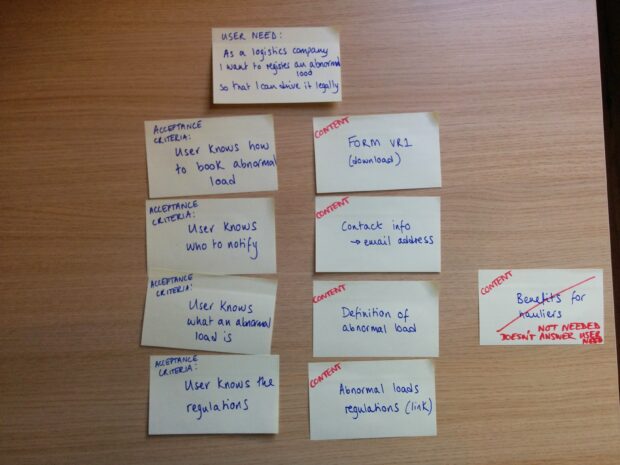From training hundreds of content designers across government and agencies, I’ve had a glimpse into what people find difficult about content.
It seems it’s not necessarily that words and sentences are hard to write, it’s more the idea of ownership of content that people can find hard.
The layers of emotion and history in there should not be underestimated.
We’ve talked in training sessions about how we can be reluctant to change content. Maybe because your boss wrote it. Maybe it was done a long time ago and you’re not sure about that process. You might feel awkward about changing something a colleague wrote. You may feel your writing isn’t that ‘good’.
It’s these perceptions that weigh us down
Remember when you were new in your job? You might have read some of the content on the website in preparation for your interview. You were excited, of course, and also a little bit nervous. You might have come from a different industry. Perhaps you’d had a bit of a break from work. What you learned in those first few weeks set the scene for you, it gave you context.
When you look back at that website and talk about re-doing that content, you’re writing over something that feels important.
Rewriting for the sake of it
Rewriting a 300-page PDF might not be everyone's idea of a great week at work. It’s not just the sheer amount of words, it’s also the structure. How else could it be explained? It’s perfectly logical to say it in the order you do the process in, isn’t it?
Once you’ve read through it, it’s very difficult to imagine it in any other way. Rewriting it feels pointless. Dusting the edge of an overloaded table. You won’t have really done anything.
There is the idea that this content has been written and approved already. Why should we have to go through all that again? It was hard enough the first time.
Where to start
We know more about our users now than we ever have done before. This can help us make life easier for them.

An exercise we do in training looks at how to structure content starting with the need. Write it out on a post-it note or card and put it on the table. Next, write out all the different acceptance criteria (the checklist of what the content needs to include) on separate post-it notes or cards and put those on the table too. Arrange the acceptance criteria in the order you’ll answer them in the content.
Once you’ve arranged them, take a quick break and go back to it.
Don’t miss this step out. It’s easier to rejig a few cards on a table than it is to rewrite that 300-page document, so give yourself enough time to get it right. You might also want to get some input from colleagues to make sure you’re answering the actual user need, not your version of it.
This card exercise will help you take the emotion out of the content. Seeing it on the table makes it feel easier to deal with. You’ll be able to get some perspective.
Action at the top, background at the bottom
Once you’ve agreed your structure - think action first, background later - move on to thinking about the actual content. It’s much easier to add information in - don’t start with your existing stuff and try to take some out.
Every time you add, look up to the user need and ask yourself: “does this help the user do their task?”
Think about how often a user will come to the content. Have they done the process before? What evidence do you have about them that will help you at this stage?
Things we don’t talk about when we talk about content mostly involve emotions. Sentimental and fearful ones, maybe the odd angry one. Being a good writer doesn’t come from being a robot, we do need those emotions to help keep our users in mind.
Follow Christine on Twitter, and don’t forget to sign up for email alerts.


5 comments
Comment by Gillian posted on
Thanks for sharing, Christine. I have a similar question to Huw. How did you apply the user need process when dealing with the Inside Gov policy content which is more about telling what the government is doing?
Comment by Huw Pritchard posted on
Christine - how do you apply this when the content is 'marketing' information, such as government promoting a new business support programme? Very good piece by you of course!
Comment by Christine Cawthorne posted on
Hi Huw, we have lots of conversations about this in training sessions too!
I'd say you would go back to the point of that campaign - what do people need to know? Frame it with them in mind, not the organisation.
If you are getting them to the content via other channels (eg social links) then make sure you are answering questions and being genuinely helpful. Ask people in your target audience what they would find most useful.
Comment by Tom Dolan posted on
Surely it would be better to say that the process changes your emotional relationship with rewriting the content.
I don't think we should ever be encouraging people to take the emotion out of content itself as a default. Our relationship with good content isn't that a spec was fulfilled - it's that we were changed and can remember the process of that change. Nobody interacts with government through choice, but that doesn't mean we aren't responsible for an emotional transformation. Fear to empowerment, alone to heard, frustrated to fulfilled etc.
Comment by Christine Cawthorne posted on
Good point about changing the nature of the relationship Tom.
I agree, we don't want the emotion lost completely, but we need it to be put into the context of people coming to use the content.